Muhammad's position in Mecca was becoming more and more unsupportable (due to his insistence on one god rather than the many that the Meccans worshipped). He sought to establish himself in Taif without success.
Sunday, December 6, 2009
HIJRA: PIONEER OF "THE PEOPLE FIRST" LEADERSHIP CONCEPT
Muhammad's position in Mecca was becoming more and more unsupportable (due to his insistence on one god rather than the many that the Meccans worshipped). He sought to establish himself in Taif without success.
Sunday, November 29, 2009
15 CATTLE FOR EID ADHA IN KUNAK
Thursday, November 26, 2009
ASTEROID - CAUSE FOR BONE BAY EXPLOSION
Wednesday, November 25, 2009
INACTIVE BANK ACCOUNT REASON FOR LATE DELIVERY WELFARE FUNDS
Tuesday, November 24, 2009
HELPING FARMERS TO IMPROVE PRODUCTION
 Kunak, Nov 24--The Sabah State Government is continuously putting effort to improve the income of farmers and raise the standard of living of people in the rural areas. Personnel from various government agencies and departments are frequently deployed to kampongs to assess how citizens in the rural areas make their living and evaluate areas where the government can channel resources to help them improve production.
Kunak, Nov 24--The Sabah State Government is continuously putting effort to improve the income of farmers and raise the standard of living of people in the rural areas. Personnel from various government agencies and departments are frequently deployed to kampongs to assess how citizens in the rural areas make their living and evaluate areas where the government can channel resources to help them improve production.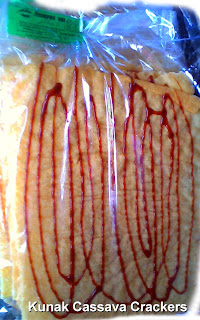 This morning, personnel from the Agriculture Department, three from Kota Kinabalu and one from Kunak made a visit to Kampung Cenderawasih, about 9 kilometers from Kunak Town. They visited an entrepreneur processing cassava crackers and a sugar cane farmer.
This morning, personnel from the Agriculture Department, three from Kota Kinabalu and one from Kunak made a visit to Kampung Cenderawasih, about 9 kilometers from Kunak Town. They visited an entrepreneur processing cassava crackers and a sugar cane farmer. Sugar cane in Kunak is grown mainly for producing fresh sugar cane juice and mostly sold at the two weekly markets in town, Pasar Rabu (Wednesday Market) and Pasar Minggu (Sunday Market).
Sugar cane in Kunak is grown mainly for producing fresh sugar cane juice and mostly sold at the two weekly markets in town, Pasar Rabu (Wednesday Market) and Pasar Minggu (Sunday Market).Saturday, November 21, 2009
COAL-FIRED POWER PLANT AT KAMPONG SINAKUT WILL NOT POLLUTE ENVIRONMENT

 Currently almost 40% of East coast power requirement is imported from West Coast Grid System with daily average of 100MW. The daily West-East power transfer is forecasted to deteriorate further to 70% by 2010. Such huge power imbalance will render the power supply extremely unreliable and unsecure. In the event of interruption of East-West link, a not unlikely possible considering its long 270km line, it will be exposed to risk of total blackout due to insufficient generation capacity within the East Coast Grid.
Currently almost 40% of East coast power requirement is imported from West Coast Grid System with daily average of 100MW. The daily West-East power transfer is forecasted to deteriorate further to 70% by 2010. Such huge power imbalance will render the power supply extremely unreliable and unsecure. In the event of interruption of East-West link, a not unlikely possible considering its long 270km line, it will be exposed to risk of total blackout due to insufficient generation capacity within the East Coast Grid.Thursday, November 19, 2009
PRAWN REPLICAS - NOT APPROPRIATE FOR KUNAK
Landing at Tawau airport from Kota Kinabalau last night, I met with a friend who was about to board a plane to Kuala Lumpur. He greeted me with a question, “Why prawns?”
Astonished, I asked back, “What about prawns?”
Smiling, my friend, a local Tawau chap explained, “I wonder, why the hell you people of Kunak put up three big, concrete prawn replicas at the Kunak town roundabout? It gave me the impression that Kunak is a main producer of big prawns. So, I went to your wet market, you know… to buy some big, cheap prawns!”
He began to giggle.

The Prawn Replicas Under Construction in Kunak
“You know what?” the giggles turned to big laughter, and said, almost shouting, “I can’t find a single prawn!”
He continued to tease, hurting my feeling and pride “Since you don’t have prawns to offer, I bet your giant prawns represent the Malay proverbs, Otak Udang (Prawn Brain – meaning “fool”) or Udang Di sebalik Batu (A shrimp behind the rock – meaning “to have hidden agendas”).
Embarrassed, I just managed to put up a wry smile. What can I say? He was right. Kunak fishermen do not catch enough prawns to cater even for local consumption.
Disturbed by my friend’s remarks, I phoned the Kunak Pemimpin Kemajuan Rakyat (People’s Development Leader) this morning to find out whether he has any information on how the decision was made to put up the prawn replicas. He told me that neither he nor the local state assemblyman, Datuk Nilwan Kabang, was consulted on the matter.
Personally, I would prefer any of the following replicas:
- Replicas depicting activities of the prehistoric hunter-gatherers that took place in Tingkayu in Kunak District sometime in 30,000 BC;
- Activities of oil palm harvesters as palm oil is the main produce of Kunak; or
- Zalacca fruit to represent Kunak as the first snake fruit propagator in the state.
REQUEST TO REPLACE STALLS WITH SME COMMERCIAL CENTER
Kota Kinabalu, 17 November 2009. The State Assemblyman of Kunak, Sabah Datuk Nilwan Kabang today requested the Sabah State Government to setup a commercial premise taking the model of the Tawau Central Market or the Alor Star Pekan Rabu building, to replace the make-shift stalls of Gerai Simpang Empat.
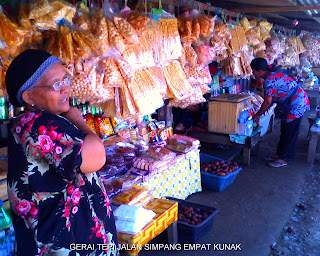
Simpang Empat Stall in Kunak
"Beginning with three stalls constructed by the locals some twenty years earlier from discarded planks for frame and corroded zinc sheets for roofing, the number of stalls steadily increased to the present number of more than twenty”, said Datuk Nilwan.
"Therefore, I hereby request for some of the 2010 budget provision for development be channeled to construct a commercial center for SME and agricultural products at the Simpang Empat Stall site, to replace the make-shift stalls”, added Datuk Nilwan.
According to Datuk Nilwan, Kunak is an invaluable latent tourism treasure, only that, developers of the tourism industry are too preoccupied with products that they already have, that they tend to overlook this “tourism gold mine”.
The Kunak Tourism Package integrates crucial elements for tourist attractions including prehistoric background, eco-tourism, agro-tourism and marine-tourism.
Thursday, October 8, 2009
A BLAZING OBJECT PLUNGED INTO BONE BAY, INDONESIA
The huge "fireball" that plunged into the waters of Bone Bay in Southern Sulawesi, Indonesia at 11.23 local time today remains a mystery. An eye witness claimed that the ablaze object was oblong. It plunged into the sea with 5 or 6 explosions.
What could it be?
Thursday, October 1, 2009

- To publish a book entitled Glimpses of Silam
- Research on the history and tourism in Silam Area
- Research on selected schools in Silam
- Research on the socio-economy in Silam, particularly in Segama
- To carry out environmental campaign with Silam community
- To help enrich information and promotion of the Madai Forest Reserve
- To propel agricultural and livestock research especially in Kampong Cocos
- Marine and geological research in the islands around Darvel Bay
- Research on the potential of marine food products and other local resources particularly in the District of Kunak.
Saturday, July 11, 2009
RELIEF FOR JULY 7 FIRE VICTIMS
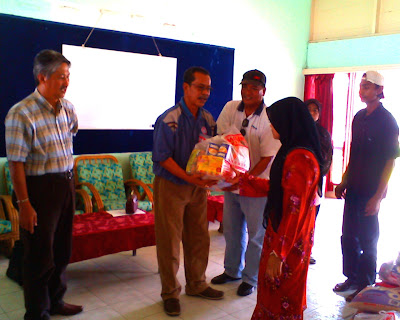
The contribution was donated by Perbadanan Baitulmal Sabah (Sabah Islamic Relief Board) and brought from Kota Kinabalu by one of the Board’s officer, Ruhaizad Mohd Salleh. Also present were Kunak Assistant District Officer, Hussin Haji Ibrahim, Kunak District RELA Officer, Lieutenant Colonel Rosmi Saad and staff from Kunak Community Development Unit.

Two days earlier on July 9, the Silam Member of Parliament Tuan Haji Salleh Kalbi also visited and distributed groceries to the victims.
Thursday, July 9, 2009
21 FAMILIES LOST HOME TO FIRE

KAMPUNG BAGIANG KUNAK May 8, 2009. Eleven houses were burnt down to the ground at Kampung Bagiang in Kunak on May 7, 2009 leaving 71 people of 21 families homeless. The local State Assemblyman, Nilwan Kabang who yesterday rushed to the site of incident when the houses were ablaze revisited the charred zone this morning. He was accompanied by the District Officer, Susilo Sumarto and officials facilitating the process of delivering relieve to the victims.
Some of the victims are now staying with relatives while others seek refuge in makeshift relief centers at the rest house and nearby mini halls. A spoke-woman from Kunak District Welfare Department says that cooked food will be distributed to the victims during the first three days from the incident. In addition, each family of the victims shall receive disbursement of RM 3,000 for purchase of basic daily necessities.
In response to a question by the press, the District Officer said that he will arrange aid to the victims in accordance with the regulation of the Natural Disaster Relief directive.


On a question to whether the victims be given houses under the House for the Poorest Scheme (PPRT), YB Nilwan responded, “That form of assistance is given to those who passes the criteria outlined under the scheme”. He added that efforts are being undertaken to provide more decent housing sites for families of the victims to rebuild their houses. Meanwhile he advised them to be patient in face of this hardship and to keep in touch with the local authorities.
This fire incident is the third in the district within the last four months. The two previous cases were both at Kampong Sungai Atas, that is on April 9 where a house was burnt to the ground and on June 21 when three houses caught fire and turned into an inferno.
Wednesday, July 8, 2009
TEACHING AND LEARNING OF SCIENCE AND MATHS IN BM & MOTHER TONGUE IN 2012
Malaysians particularly parents should accept the decision positively and with open mind. We must realize that the decision was not made lightly, not dictatorially, free from sentiments and from pressures. Experts in this particular field made it after careful and extensive studies.
Personally I fervently hail the announcement for reasons as put forward in a post, “Pengajaran dan Pembelajaran – Guna Bahasa Yang Paling Difahami” (Teaching and Learning – Use Languages That Are Most Understood) in my Malay blog, kunakians, on Jun 25, 2009.
Current first graders will be fourth graders by the time this latest strategy come to effect in 2012. In the meantime, science and mathematics teachers shall be teaching in bi-language.
We, parents ought to look into the schedule for the implementation of the strategy and help prepare our children so that they are eagerly ready to take up the lessons in their own mother tongue when the day comes.
I prepare the timetable below to help me track which classes my children will attend within the next ten years. I hope it somehow can also give some assistance to fellow Malaysian parents out there.

Saturday, July 4, 2009
ON TRAIL OF THE HISTORY OF KUNAK - PART 8

The industry had also brought to light the artistic talents of the early settlers as revealed by the decorative designs on many of the broken pieces of potteries found at the Bukit Tengkorak Site. Whether the decorations have any hidden message or not is still open for discussion. Nevertheless about the same time (3000 BC) in the north, the ancient Egyptians and Sumerians introduced the first writing in the form of hyrogliphic and cuneiform.
In Mesopotamia, people had practiced agriculture for at least 3000 years. Around 4000 BC the Sumerians constructed canals to irrigate fields as well as transporting their agricultural products by boats to the cities. They have improved their roads where their donkeys trod, some pulling carts on wheels. There were at least 12 Sumerian cities and Ur was one of the biggest with a population of about 24,000. With big population came job specifications that brought about the birth of the Sumerian civilization in 3800 BC.

Agriculture was also in practice in South East Asia including in Madai, Kunak. As the population was very small agriculture was not practiced in big scale, not as intense as in Sumer. The small ratio of population to vast arable lands enables each clan to pick their favorite spot for farming without much disturbance or competition. With the absence of struggle for arable lands, the tribes left areas that had been used for planting several times, and considered not fertile, to open new areas. They became shifting cultivators.
It is still not very clear what type of crop the early settlers in the east coast of Sabah had planted. The most logical guess is, it could be plants that are endemic to the region such as yam and taro. Rice could have been introduced from Taiwan. It could also be brought by sailors from Sulawesi where archaeologists had found traces of the crop dating back to 3000 BC.

The practice of shifting cultivation had brought about to further colonization of the vast area in Sabah and Borneo as well as in other parts of South East Asia. As families became bigger, they split and went their separate ways to colonize new areas. As time went by, their dialects, beliefs and customs evolved independently leading to the rise of many different ethnic tribes. (See the blog abdnaddin or MySabah for images)
Rice was planted where the crop could grow well as in an area around the cave Gua Sireh in Sarawak where traces of rice that date back to 2000 BC had been found. Meanwhile, the Madai Caves, the last cave dwellings in Kunak, remained uninhabited apart from occasionally used as temporary shelters from 2000 BC to 500 BC.
Friday, July 3, 2009
Blogger Turns 10: What's your story?
Dear Blogger,
This is a respond to your invitation on blogger.com dated 18 Jun 2009. This is my story and of what Blogger has meant to me.
I tried my fingers on the web sometime in the year 2000. Back then, in my hometown here in Sabah, there were not so many of us who had access to the internet. Data transfer was also very slow. I used the internet mainly to get information related to my job at that time as an Oil Palm Plantation Estate Manager. Websites that I frequented most were those hosted by The Malaysian Palm Oil Registration and Licensing Authority (PORLA) and Palm Oil Research Institute of Malaysia (PORIM). The sites had helped me to keep updated with issues pertaining to the oil palm industry particularly on the highly fluctuating market.
I joined Blogger on March 2009 with my blog, Kunakians, which literally means The People of Kunak. Kunak is a small town on the east coast of Sabah, Malaysia. Little did I know then that there is another place in the world known as Kunak (in Kazakhstan) until I recently, thanks to Google earth.
My first post at Kunakians is in Malay or as we, Malaysians, like to call the language Bahasa Malaysia (the Malaysian Language) just to distinguish it from the Indonesian Malay Language. The article is in the form of a report on the activities of 70 elderly village headmen attending an outward-bound course on an isolated island.
On April 27, 2009, I introduced another blog at Blogger, Kunakians2, to post my articles that are written in English. The first post, Luffa Aegyptiaca, still bears the report format with a little sense of research.
Following a power crash on April 29, 2009, my hard disk was badly damaged and I had to replace it with a new one. Indeed, I lost innumerable valuable data, including materials on the subject of the history of my hometown, Kunak that I have accumulated over the past four years.
After getting a new hard disk and installed the operating program, I browsed the web using Google Chrome. I was so happy to see that the articles and images that I had posted on Kunakians and Kunakians2 are still there. It makes me realized that one of the benefit bloggers get from blogging is the safekeeping of articles. Now, I am back to gathering information on the history of Kunak, write whatever I can and immediately post it to Blogger for “safekeeping”.
Wide interactions with people have brought me to frequent open discussions. Some offers ideas while others asked for opinions. I post subjects that in my opinion are worthwhile to share with the public.
A few weeks back, I was at a coffee house with three friends when we overheard the afternoon news from the coffee house TV set mentioning a pandemic called Influenza A(H1N1) which has been confirmed to be affecting Malaysians. One of my friends, the eldest among us asked, “What kind of illness is that? Is it similar to AIDS?”
As a Microbiology graduate, somehow I managed to recall some information about the topic so I said to him, “Influenza shows symptoms similar to that of common cold, fever, coughing, headache and the like. But I’m not very sure of H1N1”.
“If an illness is on TV, it is dangerous”, quipped another friend scratching his quite bulging belly.
Our eldest companion began to look worried. The piece of roti canai (Indian bread) he was about to deposit into his gaping mouth stopped in mid air. “Is there any medication for it?” he asked intently.
“Don’t worry so much. Our friend here will find out and tell us about it”, said our friend with the big belly. Pointing at me, he continued, “Our friend here was a science teacher. He should be able to find out how to avoid getting that illness and to find out whether there is medication for it or not”. He went further to tap my back, too hard, that I can tell because it hurt, and added, “You can, right?”
“I’m not sure, Panglima”, I replied honestly. “Maybe I can find some clues about it from my old college textbooks and lecture notes. Maybe there are some information on the web as well”. (Note: Panglima is a Malay word for warrior. Here, in Kunak we amiably called a friend Panglima as a sign of mutual respect).
As soon as I get home, I began to dig into my old lecture notes and textbooks on virology, browse the web for accounts on the new pandemic then scribbled some notes. Three hours later, I found myself struggling to type an article in the simplest term that I can think of for my friends at that coffee house. I came up with, “Mengenal dan Menangani Influenza A(H1N1)” (Identifying and Coping with Influenza A(H1N1)) which I posted at Kunakians on May 29, 2009. I printed three copies of the article and distributed them to my three coffee-house friends.
I posted a serial “Keajaiban Nombor” (The Fascinating Numbers) following suggestions from some of my ex-students who claimed that the method of calculating I taught them when they were in school had helped to improve their mathematics. They also mentioned that the skill is also very useful in everyday life.
There is so much to tell on Blogger and I albeit of myself being just joining a few months back, what more of those who have been with Blogger from the start.
For me, it is suffice to sum up with two main reasons for me to keep on posting to Blogger:
- It is the best way to share information with people around the world who find the information in my posts worthwhile, while realizing that I tried as much as possible to avoid hurting or discredit anybody.
- It is a safekeeping place for ideas that may never come again.
Friday, June 19, 2009
ON TRAIL OF THE HISTORY OF KUNAK - PART 7

Around 30,000 BC, in place now known as Indochina, several tribes from the band that included the Tingkayu Tribe, broke away and took a different path (see part 2 of this series). They arrived at a place now called Taiwan. Like the Tingkayu Tribe they continued their tradition as hunter-gatherers for 20,000 years.
As the massive ice blocks melted and flooded the lowlands, Taiwan was cut off from mainland Asia and the Malay Archipelago. Their hunting and gathering grounds shrank while their population increased causing shortage of food. In such a challenging situation, the human mind was forced to work and function more efficiently. The Taiwan Tribe began to explore into two new ventures that were vital to their survival. First, they began to practice agriculture to ensure continuous supply of cereal. Second, they learnt to construct rafts and boats to cross lands across the sea for hunting and gathering. In the course of their adventures, some had crossed back to mainland Asia while others arrived at Luzon Island in the Philippines.
In Part 5 of this series we mentioned that sometime in 16,000 BC, some group from the Tingkayu Tribe had crossed from Kalimantan to Mamuju in Sulawesi. They were the ancestors of the Sulawesi Tribe, the pioneers of sea travel. Their descendants kept on improving their sailing skill and in the construction of sea-going vessels that had made them the most competent sailors in the southern hemisphere and earned them the nickname “Vikings of the South Seas”.

With the sinking of the land bridges, the Sulawesi Tribe became advocates that re-linked tribes that had been separated thousands of years earlier. Sea travel had brought them to Java, Sumatra, Borneo, the Philippines, the Pacific Islands and Australia. With the arrival of the Taiwan Tribe, the long separated people of common ancestry were reunited. Intermingling among them had generated a blended culture, characteristics, temperament and skills of a big family referred by anthropologists as the Austronesian.
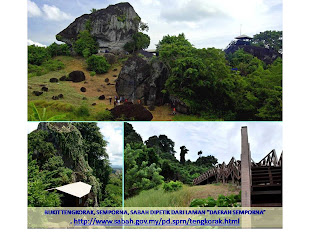
At Bukit Tengkorak Semporna, experiences and skills were shared among the tribes particularly, though not the only, in pottery industry. Archaeological findings indicated that those tribes of different groups had interacted with each other around 5,000 BC or perhaps earlier. This is manifested by the similarities in pottery and microliths excavated in Bukit Tengkorak with those from other sites dated back to between 5000 BC to 4000 BC at Madai and Baturong in Kunak, at Balobok in the Sulu Peninsula, at Leang Tuwo Mane’e in the Talaud Islands, as well as at Paso and Ulu Leang in Sulawesi.
Friday, June 12, 2009
ON TRAIL OF THE HISTORY OF KUNAK - PART 6
Thousands of stone tools had been excavated from Madai caves. The tools were mostly made from local river pebble chert, of an industry similar to that of Baturong. Mortars that were used by the prehistoric people of Madai for grinding food, cracking shells or ochre preparations were also found.

The presence of abundant shells in Madai Caves indicates that the inhabitants frequented the shores to gather seafood from the beaches. Hunting of animals continued. The hunted animals include large animals such as seladang and two species of rhinoceros, i.e., javanese rhinoceros (Rhinoceros sondaicus) and sumatran rhinoceros (Rhinoceros sumatrensis). Today, javanese rhino no longer exists in Sabah.
Around 5,000 BC the Madai Caves were abandoned. There are no detail studies yet to determine the reason for the inhabitants to leave or where they had gone.
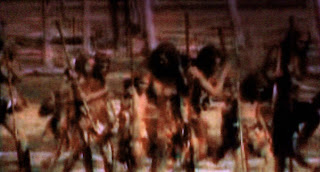
However, with their skill in manufacturing many types of stone tools for any particular purpose, the Madai Tribe must had tools for cutting trees and woods. With the warmer climate, they did not need the caves for shelters against the cold nights. Human nature to continue in search of comfort and wellbeing had driven the tribe to move closer to the easy source of food. They had found easy source of food from the beaches that assure them that their family need not go through hunger anymore at times when the hunters returned home empty-handed.
Obviously, there were no reasons for the Madai Tribe to continue living and sharing the damp, dark caves with bats and swiftlets. They were fed up with the thickening guanos on the cave floor. Thus, the tribe left the cave and moved out closer to the beaches.
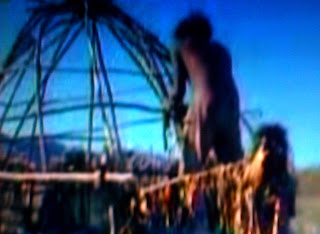
With their skill in manufacturing stone tools for any particular purpose, they had no problem in making tools specially for cutting trees and woods. They began to build shelters from small timbers, barks, vines, rattans, and palm leaves. Hence, in 5000 BC the foundation of kampongs began in the District of Kunak, Sabah.
Friday, June 5, 2009
COMMUNISTS ARE WAITING FOR THE RIGHT MOMENT TO STRIKE
Wednesday, June 3, 2009
BEST TIME TO HARVEST SWIFTLET'S NEST
The New Sabah Times (3rd June 2009) quoted Datuk Karim as explaining that harvesting (of the birds’ nests) must be conducted in adherence to GAHP and only at suitable times.
“The best time to harvest is when the nests are empty, and not when there are eggs or young birds in them,” said Karim.

A few years back Datuk Karim built a three-storey building in Kimanis specially for swiftlets to colonize but he had to wait for at least two years before any swiflets decided to set up home there. He had been patient and once a wallet or two started building nests, more will flock in to the building.
Now he has a few hundred “wallet” birds in his building but he is not in a hurry to harvest the nests just yet. He wants them to continue building the colony. He also does not want to disrupt the birds’ environment at this moment as the birds might just leave for good if the peaceful environment is disrupted.
The population of wild swiflets also decreased due to the destruction of their habitat.
Saturday, May 30, 2009
ON TRAIL OF THE HISTORY OF KUNAK - PART 5

We pick up from our last story that took place around 16,000 BC when the Tingkayu Lake drained out. The tribe scattered to other parts of South East Asia. Some might even met other tribes, their cousins, who had been there earlier.
That time the sea level was up to 300 or 400 feet lower than today so that the group that travelled south through Balikpapan would come to the shore where they can clearly see the highland of Mamuju in Sulawesi.
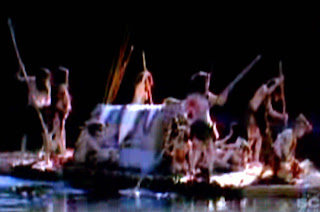
The water that separated them from the land that looked so rich and green was only a few kilometers distance. Being adventurous and curious, some took up to the sea with rafts and crossed over to settle in Sulawesi. It is thus not surprising that later on the people of Sulawesi emerged as one of the most prominent seafarers. Their ancestors are the pioneers of sea travel.
Back in the nearby Baturong Caves, the remaining tribe continued with their usual life as in Tingkayu. However, they did not stay for long. Around 10,000 BC the shelter at Baturong was in turn abandoned. It was the end of the Ice Age. The massive blocks of ice that had covered most part of Europe and Northern Asia melted and flowed down, the sea level rose separating Borneo from mainland Asia, Palawan, Sumatra and Java. Borneo found its present shoreline and the coastal environment moved significantly towards the Madai-Baturong region.


Coastal resources were laid within an easy day’s walk from the Madai Caves. To get closer to the new resources, the people of Baturong moved in to two of the large caves at Madai, Agop Atas and Agop Sarapad. Archaeological studies proved that the two shelters were intensely inhabited during the early Holocene, between 10,000 and 5,000 BC.





